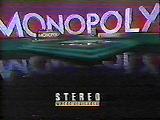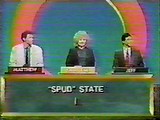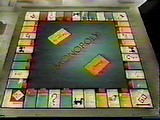Monopoly
From RulesWiki
| MONOPOLY | |
| The Monopoly set and title. | |
|---|---|
| Airdates: | ABC July 1990 - September 1990 |
| Host: | Mike Reilly |
| Models: | Kathy Davis, Michelle Nichols, Kathy Karges |
| Announcer: | Charlie O'Donnell |
| Producers: | Merv Griffin Productions |
Gameplay
Three players competed. The first part of the game was spent going around the board, accumulating properties on the board. Starting at Mediterranean Avenue, the players were given a toss-up clue, along with the first letter of the answer. The player who buzzed in with the right answer claimed the property and got the value of that property added to his score. If a player answered incorrectly, the value of the property was deducted from his score. If nobody answered a clue correctly, another clue was given with the value cut in half.When a particular color group was finished, those who claimed at least one property would then play to acquire a monopoly on the color group. In order to win the monopoly, the player needed to answer as many clues correctly as he lacked in properties. (Hence, a player with two properties out of three needs just one right answer to win the Monopoly; his opponent would need two, and had to provide both correct answers consecutively or else forfeit the Monopoly to the other player.) If all three players were involved in a color group, the player who answers the first clue correctly got to choose his opponent for the other clues. Winning the monopoly also added the combined total of all the property values in that group to the player's score. This process repeated until all properties were distributed, with clues on each strip of the board starting with a new letter.
During the ensuing commercial break, players could elect to spend their earnings on houses and hotels in order to inflate the rent values of their properties. Houses cost $50 apiece, while hotels cost $250. Afterward, the second round began, which entailed travelling around the board. Starting at GO, the board marker would move according to the dice rolled by the model. The following action depended on where the marker landed:- Property: The player in control of that property got first guess of a clue for the rent attached to that property, risk-free. If incorrect, the other players could jump in to steal the rent money, but had the rent value deducted if they were wrong. Rent values ranged from 1/2 the property's original value to the full amount of the rent with hotel according to the board game.
- Utility: A clue was played for $100 times the most recent dice roll.
- Railroad: Players got the chance to travel to an opponent's color group and attempt a "Hostile Takeover". One clue was read; the winner of that clue then selected a color group to usurp, and then answered one clue for each property in that group. If successful, that player took control of that monopoly. If one wrong answer was given, the player would have to pay the property owner the rent value of that property.
- Chance/Community Chest: A card was drawn and its directons were followed, usually involving the position of the board marker or the scores of one or more players.
- GO: All three players got $200 for passing GO and $400 if the marker landed exactly on GO.
- Go to Jail: The marker was sent to Jail, and all three players had to pay $250 to get out.
- Income/Luxury Tax: Each player lost 10% of their score or $75, respectively.
- Free Parking: One clue was played for a jackpot of $500, plus any fines paid earlier in the round.
After five minutes of play, all houses and hotels were sold back to the bank for their original selling price, and the player with the most money got to keep it and advanced to the bonus round.
In the bonus round, the object was to make a full lap around the board in five rolls or less, without landing on a Go to Jail space. In addition to the usual space, the contestant had to add four more Go to Jail spaces: one on the second strip of the board, one on the third, and two on the fourth. The player then rolled the dice himself. Each space that the player advanced past on the board earned $100, which could then be kept to stop the game or risked on the next roll. If doubles were rolled, the player got a bonus roll. Landing on a Go to Jail space or failing to make it around the board when all rolls were used up ended the bonus round and lost any accumulated money in that round. If the player made it past GO, the contestant won $25,000 for merely passing GO and $50,000 for landed exactly on it.





